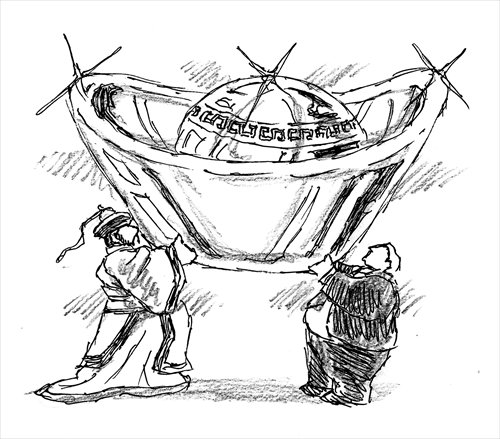HOME >> BUSINESS
China’s gold-buying spree has innocent goals
By Chris Dalby Source:Global Times Published: 2016-2-18 22:48:01

Illustration: Peter C. Espina/GT
Since 2010, China's gold reserves have soared by over 700 percent. Some analysts view China as preparing for a future economic crisis by hoarding solid assets it can hold onto until the time is right. Given that gold is now at an eight-month high, this seems like a plausible option. The truth, however, may not be so grim.
With a strong US dollar, low oil and commodity prices, gold is not just an investment for a potential recession; it is simply an asset that has proven its long-term price potential. China holds trillions in US debt and has extensive resources of rare-earth metals. Analysts need to understand the difference between panic buying and a country diversifying its asset base.
The reasons behind China's gold acquisition are more complex than they appear. Nor is the country the massive gold hoarder that it appears to be. At the end of 2015, China held 1,762 tons of gold, as opposed to 8,133 tons for the US. Italy and France both have far more gold reserves than China with over 2,400 tons apiece. One large difference when comparing China and other countries is the amount of foreign reserves held in gold. For the US, 72 percent of its foreign reserves in 2015 were in gold, 66 percent for Germany, 60 percent in France and just 2 percent for China.
This large difference can be explained by several factors. The US benefits from the fact that the US dollar is the world's foremost reserve currency, meaning that it has very little need to hold foreign currencies in reserve.
The same goes for France, which enjoys the global clout of the euro. For China, until recently, the yuan was not a reserve currency, meaning that the country accumulated foreign currency, especially dollars.
However, holding dollar-denominated debt is no longer the hot ticket that it once was. A few years ago, speculation ran rampant that China could simply cash in the trillions of dollars in US debt to bankrupt the American economy.
This showed a fundamentally flawed understanding of how debt works but it did highlight that US debt was in demand. China still held a significant amount of US debt, estimated at $1.2461 trillion at the end of December. But by that point, the talk was more about China's rush on gold.
Last year, China and Russia went on a gold-buying spree, with China's gold purchases rising 48 percent in the first half of 2015. In October, monthly imports reached a 10-month high, with 97.4 tons imported.
The reasons for these purchases are not sinister. China is not squirreling away resources in anticipation of a stock market crash or economic meltdown. The main reason is that it has never been wise to maintain too many assets in a single area. The inclusion of the yuan into the IMF's basket of reserve currencies for its Special Drawing Rights last year is evidence that the currency will become a larger player internationally.
With more transactions progressively being settled in yuan, if only for China's foreign trade, Beijing's need to rely on the dollar is reduced. This makes it high time for China to diversify its assets, for which the ever reliable gold is a strong commodity.
The second reason for the increase in gold buying at the end of 2015 is one that is borne out every year. Chinese people demand gold around the Chinese New Year, or Spring Festival, when gifts are commonly offered to friends and family.
Finally, its fervor for the metal seems to be cooling, year-on-year, if not month-on-month. In January 2016, China bought 21 tons of gold for its reserves, down significantly from most of last year.
Although China has been one of the largest buyers of gold in recent years, if not the largest, this accumulation is still just a leading economy diversifying its asset base.
The author is a Mexico-based analyst of Chinese politics and economics. bizopinion@globaltimes.com.cn
Posted in: Columnists